1. Introduction, specifications
 After
AMD and ATI merged, users waited for a product supposed to rock
the gaming world. As time was passing, more and more details came to
the surface concerning an upcoming chipset with the codename "RD790".
This chipset has several interesting features like PCI Express v2.0 and
up to four PCI-e slots that could enable a possible Quad Crossfire
setup to further enhance video graphics performance. Gigabyte, one of
the lead manufacturers released to the market the GA-MA790FX-DQ6 with
several interesting features. This new board is supported to support the
upcoming AM2+ socket compatible processors (Phenom), which unfortunately
haven't been released yet to the market. In this review we will examine
how well Gigabyte's RD790 proposal performs against a very popular AM2
board, the Asus M2N32WS Pro, that is based on Nvidia's 590SLI.
After
AMD and ATI merged, users waited for a product supposed to rock
the gaming world. As time was passing, more and more details came to
the surface concerning an upcoming chipset with the codename "RD790".
This chipset has several interesting features like PCI Express v2.0 and
up to four PCI-e slots that could enable a possible Quad Crossfire
setup to further enhance video graphics performance. Gigabyte, one of
the lead manufacturers released to the market the GA-MA790FX-DQ6 with
several interesting features. This new board is supported to support the
upcoming AM2+ socket compatible processors (Phenom), which unfortunately
haven't been released yet to the market. In this review we will examine
how well Gigabyte's RD790 proposal performs against a very popular AM2
board, the Asus M2N32WS Pro, that is based on Nvidia's 590SLI.
- AMD/ATI RD790 chipset
Sometime ago, DailyTech posted some information about the upcoming RD790. The article mentioned that there will be two reference boards Mako and Wahoo.
Mako is the single processor reference board with support for socket
AM2 and AM2+ processors which we will review today. It consists mainly of two ATI chipsets, the RD790 and the SB600.

The PCI Express lane configuration for Mako is as follows:
two full-speed PCIe x16 slots, one physical PCIe x16 slot with four
lane signaling for physics, one physical PCIe x4 slots with two lanes
shared between Gigabit Ethernet and SATA and one PCI slot. These lanes can be further divided to deliver four PCIe x8 slots as well. PCI Express 2.0 will be supported as well.
Gigabyte delivers the first board that supports AMD AM2+
Phenom™/ AM2 Athlon™64 series processors. The GA-MA790FX-DQ6 supports
Dual Channel DDR2 1066 and comes with Quad PCIe 2.0 graphics interface
with ATI CrossFire technology support (two x16 or four x8). The chipset supports 41 lanes of PCIe 2.0 and can run CrossFire and the future Quad CrossFire.
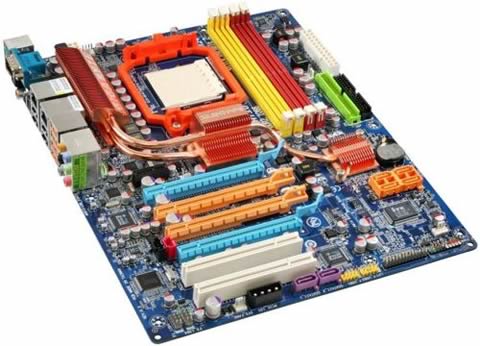
The GA-MA790FX-DQ6 uses High Quality CPU Power design with ferrite core
chokes, Low RDS (on) MOSFETs and Solid Capacitors just like the
P35-DQ6. Durable Japanese manufactured SMD (Surface Mount Device) Solid
Capacitors are used to enhanced the system durability. All New Copper
SILENT-PIPE that includes heat sinks are covering the MOSFET
modules, the north bridge and the south bridge in order to cool
the board silently.
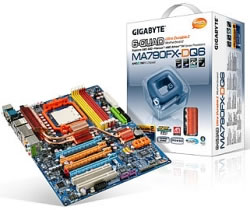
Other features on this board include a Realtek ALC 889A
codec with DTS Connect support, featuring 106 dB Signal to Noise ratio
enabling Blu-ray and HD DVD high quality Full Rate Lossless audio
playback, onboard Dual Gigabit LAN with Teaming function support and
Quad BIOS solution for multiple layers of protection. There
are also 4 eSATA ports, 1394 and S/PDIF
- Features
1. Supports AMD AM2+ Phenom™/ AM2 Athlon™64 processors and support 4000/ 2000 MT/s FSB.
2. Supports DDR2 1066 memory for outstanding system performance.
3. Quad PCI-E 2.0 graphics interface with ATI CrossFireX™ technology support (two x16 or four x8).
4. Integrated SATA 3Gb/s with RAID function
5. Features dual high speed Gigabit Ethernet and one IEEE1394
6. Ultra Durable 2 motherboard features High Quality CPU Power design
with Ferrite core chokes, Low RDS (on) MOSFET and Solid Capacitors.
7. Durable Capacitors that take advantage of Japanese manufactured SMD
(Surface Mount Device) solid capacitors for enhanced system durability.
8. All New Copper SILENT-PIPE that includes heat sinks covering MOSFET modules, the north bridge and the south bridge.
9. Audio controller from ALC 889A codec and DTS Connect, featuring 106
dB Signal to Noise ratio and supporting for both Blu-ray and HD DVD
formats.
- Full specifications
| BIOS |
- Supports Quad BIOS
- 2 x 8 Mbit flash ROM
- Use of licensed AWARD BIOS
- PnP 1.0a, DMI 2.0, SM BIOS 2.3, ACPI 1.0b.
|
| Chipset |
- AMD RD790
- ATI SB600
- Realtek 8111B Gigabit Ethernet
- T.I IEEE1394a
- Realtek ALC889A 8-channel audio codec
|
| Internal I/O Connectors |
- 1 x 4-pin ATX 12V
- 1 x FDD
- 1 x On panel
- 1 x IDE
- 1 x SPDIF in/out
- 1 x System Fan
- 1 x TPM
- 2 x IEEE 1394a
- 2 x USB 2.0 (supports 4 ports)
- 6 x SATA II 3.0Gb/s
|
| Rear Panel I/O |
- 1 x COM port
- 1 x IEEE 1394a
- 2 x eSATA
- 2 x RJ45 LAN
- 2 x SPDIF out (coaxial+ optical)
- 6 x Audio Jacks
- 6 x USB 2.0
- 2 x PS/2 (Mouse/Keyboard)
|
| Expansion Slots |
- 1 x PCI Express x1
- 2 x PCI
- 4 x PCI Express x16
|
| Other Features |
- Ultra Durable 2 Motherboard
- All cooper Silent Pipe and Crazy Cool
- All Japanese manufactured solid capacitors with SMD (Surface Mount Device)
- Over-clocking Enhanced
|
| Memory |
- Dual Channel DDRII 1066 / 800 / 667
- 4 x DIMM slots
|
| Form Factor |
- ATX form factor, 305 x 244mm
|
2. Inside the box
GA-MA790FX-DQ6 costs around 230 Euro (+shipping) ,
as found in several online stores. For sure this isn't a cheap
motherboard and aims for power/enthusiast users. The retail package has
all the needed logos to inform you about the new motherboard features:

Opening the big retail box, you can have an quick look at the board!
The motherboard is placed inside a big protective plastic hard-shell
that keeps it in place and well protected.

All included cables are showed below:
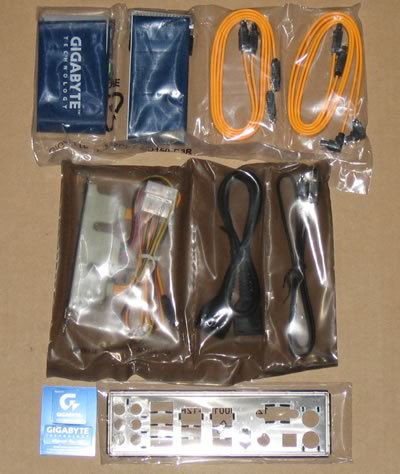
The manuals and included CDs

Below is a list of what's included in the retail package
- 4x Serial ATA cables
- 2x eSata (on two rear brackets)
- 2x USB (on two rear brackets).
- I/O Shield
- User's manual
- 2x Molex-Sata power cables
- 1x Floppy & 1x IDE ribbons
- 1x CD-ROM with drivers
- Multi-Language quick install guide
- Printed English manual
The board itself looks very "clean" as most parts can be identified
easily. Lets see how the board looks like. Lets zoom at the CPU area.

The Gigabyte GA-MA790FX-DQ6 follows the design of previous AM2
compatible motherboards. We can see the AM2 socket with plenty of empty
space around it. There are two major copper heatsinks that cool down
the RD790 (North bridge) and the SB600 (South bridge) chipsets. There
shouldn't be any major problem installing any CPU cooler with this
motherboard, all of our tests were performed with the AMD's stock cooler.

The board has properly colored the memory banks in order to properly
create Dual Channel memory setups. With the arrival of AM2+ socket
processors, memory would be unleashed up to 1066MHz, allowing further
performance improvement, compared to the previous AM2 socket. A
green IDE port is available and near the SB600, we can find four
(4) yellow colored SATA 2 connectors. There are two more SATA ports
(for RAID configurations) at the left side, as shown in the following
picture.

At the back side, we find more copper based heatsinks! This may
provide additional cooling for standard set-ups, but the larger one
will need to be removed for CPU cooling solutions requiring their own
back plate.
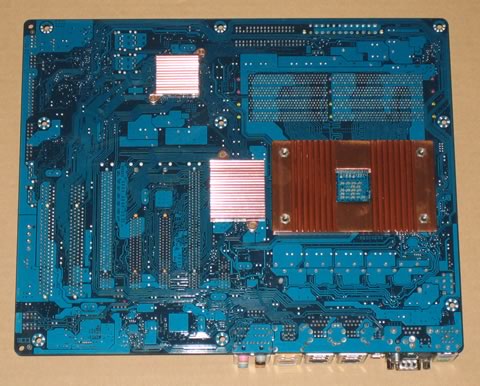
Now let's go the most interesting part, the PCI-e slots. As we
mentioned earlier, there are four (4) PCI-e that can be used in various
configurations:
- CrossFire (x16 + x16)
- Quad CrossFire (8x + 8x + 8x + 8x)
Now the bad news. The PCI-e slots are very close and probably you'll
need specific ATI based cards to perform Quad Crossfire configurations.
It would be more convenient if those PCI slots were place in the middle
in order to have more empty space in case of those big sized graphic
cards.

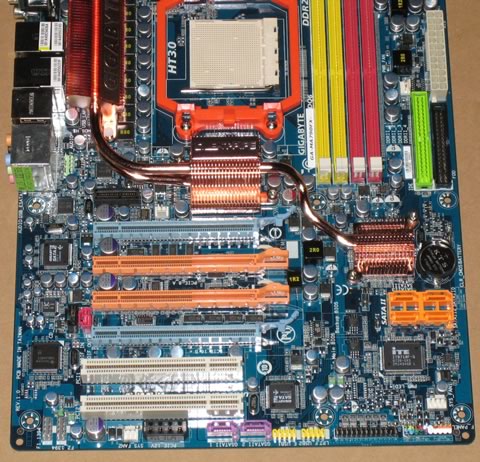
There are several extra connectors for the back of the chassis in the retail package. The I/O panel has many connectors:
- 1 x COM port
- 1 x IEEE 1394a
- 2 x eSATA
- 2 x RJ45 LAN
- 2 x SPDIF out (coaxial+ optical)
- 6 x Audio Jacks
- 6 x USB 2.0
- 2 x PS/2 (Mouse/Keyboard)
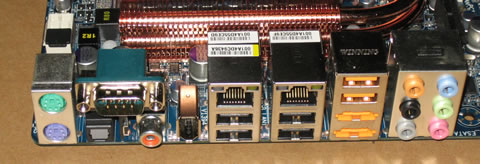
3. BIOS settings
The BIOS is Award based and the main screen is what most users have used to:

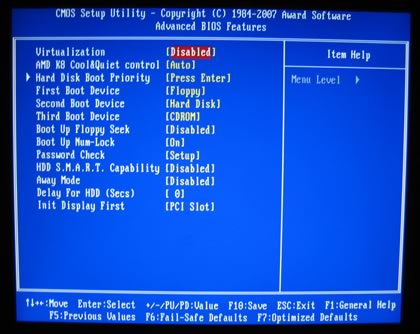
By pressing F11 you can save bios settings to a "memory file", there
are 8 available slots. This is useful since you can access different
memory/FSB/CPU schemes. Setting several important settings, for
example, disable C1E and speedstep. Another things you should keep in
mind is that by pressing CTRL+F1 unveils the "Advanced" features of the
motherboard, something that we feel should be there from the beginning.
There are three settings with various effects in performance/stability
of the motherboard
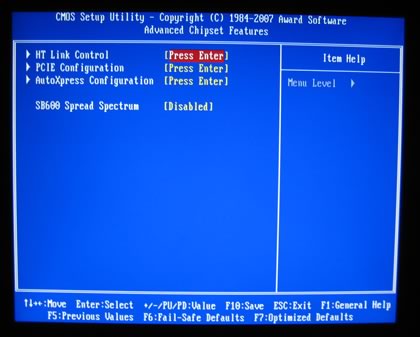
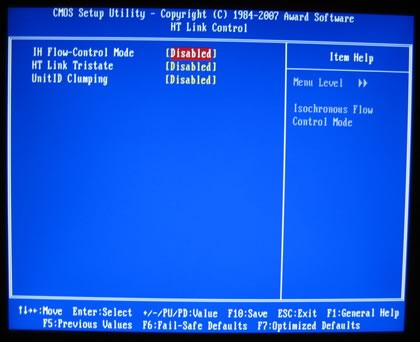


while there are several things to notice under PC Health Status tab
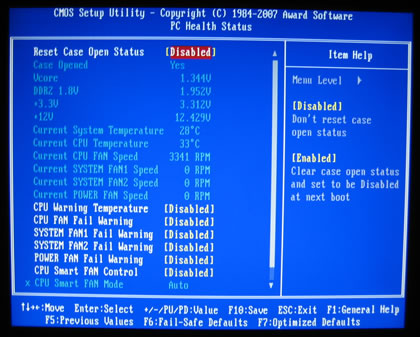
Ok, now to the most interesting part, the MB Intelligent Tweaker or
(M.I.T). Here you control all the major functions of the board, like
FSB, voltages and timings

In one screen you can set whatever you like. Let's notice the most important. First of all the HT Link can go up to 1GHz
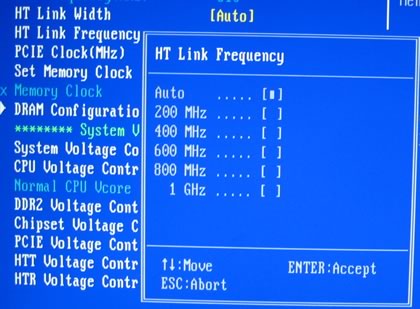
Memory Clocks can now be seen as it supposed to be, each different
setting represents a different DRAM:FSB ratio. We didn't saw the
1066MHz option, we assume this will only be available with the Phenom
AM2+ processors

DRAM timings are organized in another tab and they can be set to either manual or auto.

Several memory options are available and unfortunately, voltages
have no absolute values but instead they are in the form of +0.xx.
That's not good since you don't know the exact voltage that motherboard
has selected for your CPU/subsystems. If you are using Gigabyte's
Windows Easy Tune 5 software, you can view or set voltages from there,
but again it would be ideal to have absolute values under the Bios. The
voltages margins are not that high, we should expected more from this
board:
- FSB up to 500MHz (FSB 2000)
- Frequency bus PCI-E to 200MHz.
- Voltage CPU up to 1.9V
- Voltage DDR2 up to +0.5 V (2.3V), thus somewhat short.
- SB voltage to +0.4 V.
- Voltage PCI-E to +0.45 V.
- Voltage HTT link up +0.40 V.
- Installation
Using Everest Ultimate Edition 2007 we can get more information about the board:

Both North Bridge and South Bridge chipsets unveiled:



For all tests we used the latest available BIOS (F2B).


Let's see now how our CPU was identified using CPU-Z:


4. Test configuration
In order to compare Gigabyte GA-MA790FX-DQ6 and Asus M2N32 WSPro we
used the same components and tried to have the exact same memory
speeds. However it was nearly impossible to set CL4 with the Crucial
PC2-8000 memory, despite the fact that we pumped up memory voltage up
to 2.25V and disabled MemoryBoost function under Advanced Features. To
be exactly correct, we did managed to get the system boot under
Windows, but CL4 was not stable, even with 2.25V as Orthos stability
test showed:
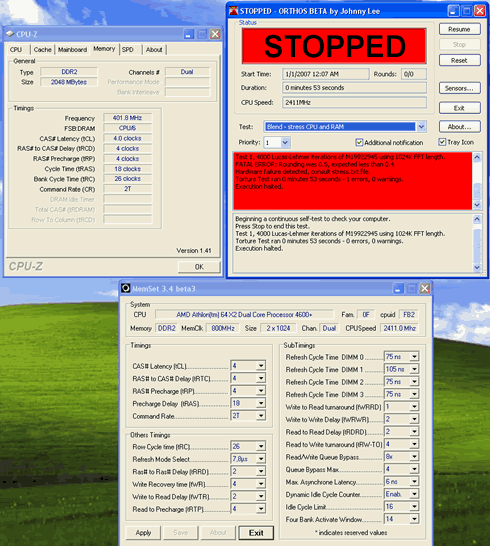
We assume this is a BIOS problem that must be addressed in the near future from Gigabyte.
- CPU: AMD Athlon X2 4600+
- CPU Cooler: Stock AMD
- Memory: 2x1GB Crucial PC2-8000 (800MHz @ 5-4-4-12-2T, 2.25V)
- VGA: MSI 7600GT Silent with Nvidia 163.71 installed
- HDD: WD 80GB SATAI (primary)
- Monitor: Viewsonic 19" LCD VP930b (1280x1024 resolution)
- Operating system: Windows XP SP2 with all latest updates installed
We used a variety of software, from benchmark to games:
- Sisoft Sandra 2008 XII
- Everest Lavalys Ultimated Edition v4.20.1170
- SuperPI Mod v1.5XS
- PC Mark05 v1.2.0
- 3D Mark06 v1.1.0
- x264 Benchmark
- Science Mark 2
- POV 3.70 beta15
- CineBench R9.5
- CineBench R10
- SysMark 2007 Preview
- WorldBench 6 beta2
- Lost Planet Extreme Conditions DX9 Demo
5. Everest Ultimate Edition 2007
 EVEREST
Ultimate Edition is an industry leading system diagnostics and
benchmarking solution for enthusiasts PC users, based on the
award-winning EVEREST Technology. During system optimizations and
tweaking it provides essential system and overclock information,
advanced hardware monitoring and diagnostics capabilities to check the
effects of the applied settings. CPU, FPU and memory benchmarks are
available to measure the actual system performance and compare it to
previous states or other systems. Furthermore, complete software,
operating system and security information makes EVEREST Ultimate
Edition a comprehensive system diagnostics tool that offers a total of
100 pages of information about your PC. The software has build-in
several tests for memory and CPU/FPU.
EVEREST
Ultimate Edition is an industry leading system diagnostics and
benchmarking solution for enthusiasts PC users, based on the
award-winning EVEREST Technology. During system optimizations and
tweaking it provides essential system and overclock information,
advanced hardware monitoring and diagnostics capabilities to check the
effects of the applied settings. CPU, FPU and memory benchmarks are
available to measure the actual system performance and compare it to
previous states or other systems. Furthermore, complete software,
operating system and security information makes EVEREST Ultimate
Edition a comprehensive system diagnostics tool that offers a total of
100 pages of information about your PC. The software has build-in
several tests for memory and CPU/FPU.

Due to the lower CL4 timings, Asus M2N32WS Pro had better memory performance in all subtests.
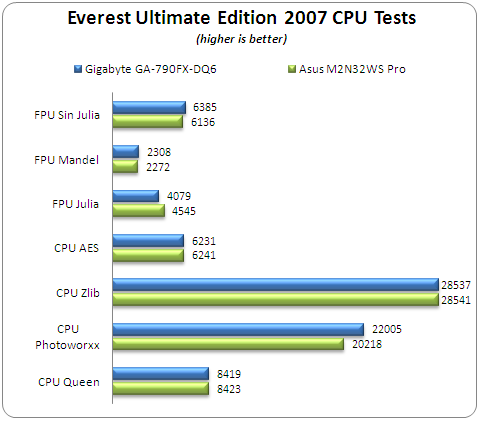
The CPU tests are also affected from the memory performance. In some
tests, Gigabyte GA-790FX-DQ6 managed to be faster and that
indicates that with CL4 timings the test results would be in favor of
Gigabyte's.
6. SiSoftware Sandra
 SiSoftware Sandra (the System ANalyser, Diagnostic and Reporting Assistant)
is an information & diagnostic utility. It should provide most of
the information (including undocumented) you need to know about your
hardware, software and other devices whether hardware or software. It
works along the lines of other Windows utilities, however it tries to
go beyond them and show you more of what's really going on. Giving the
user the ability to draw comparisons at both a high and low-level. You
can get information about the CPU, chipset, video adapter, ports,
printers, sound card, memory, network, Windows internals, AGP, PCI,
PCIe, ODBC Connections, USB2, 1394/Firewire, etc. Sisoft Sandra offers
a variety of tests for Memory and CPU.
SiSoftware Sandra (the System ANalyser, Diagnostic and Reporting Assistant)
is an information & diagnostic utility. It should provide most of
the information (including undocumented) you need to know about your
hardware, software and other devices whether hardware or software. It
works along the lines of other Windows utilities, however it tries to
go beyond them and show you more of what's really going on. Giving the
user the ability to draw comparisons at both a high and low-level. You
can get information about the CPU, chipset, video adapter, ports,
printers, sound card, memory, network, Windows internals, AGP, PCI,
PCIe, ODBC Connections, USB2, 1394/Firewire, etc. Sisoft Sandra offers
a variety of tests for Memory and CPU.

Again, the memory performance was better for Asus M2N32WS Pro. At
the CPU tests, we saw a mixed bag in and in some tests Gigabyte
GA-790FX-DQ6 was faster than Asus.


7. PCMark 2005, 3DMark 2006
 PCMark®05
is everything you need to reliably and easily measure the performance
of your PC and determine its strengths and weaknesses. With PCMark05,
you will be able to select the optimal upgrades for your existing PC,
or choose the right new PC that fits your specific needs. This
easy-to-use product gives you the same tools and knowledge that
virtually every professional tester in the industry uses. Below you can
see all three available scores, memory, CPU and total.
PCMark®05
is everything you need to reliably and easily measure the performance
of your PC and determine its strengths and weaknesses. With PCMark05,
you will be able to select the optimal upgrades for your existing PC,
or choose the right new PC that fits your specific needs. This
easy-to-use product gives you the same tools and knowledge that
virtually every professional tester in the industry uses. Below you can
see all three available scores, memory, CPU and total.

At both Memory/CPU scores, Asus M2N32WS Pro was faster...
 3DMark®06
is the worldwide standard in advanced 3D game performance benchmarking.
A fundamental tool for every company in the PC industry as well as PC
users and gamers, 3DMark06 uses advanced real-time 3D game workloads to
measure PC performance using a suite of DirectX 9 3D graphics tests,
CPU tests, and 3D feature tests. 3DMark06 tests include all new
HDR/SM3.0 graphics tests, SM2.0 graphics tests, AI and physics driven
single and multiple cores or processor CPU tests and a collection of
comprehensive feature tests to reliably measure next generation gaming
performance today.
3DMark®06
is the worldwide standard in advanced 3D game performance benchmarking.
A fundamental tool for every company in the PC industry as well as PC
users and gamers, 3DMark06 uses advanced real-time 3D game workloads to
measure PC performance using a suite of DirectX 9 3D graphics tests,
CPU tests, and 3D feature tests. 3DMark06 tests include all new
HDR/SM3.0 graphics tests, SM2.0 graphics tests, AI and physics driven
single and multiple cores or processor CPU tests and a collection of
comprehensive feature tests to reliably measure next generation gaming
performance today.

3D Mar06 tests both CPU/RAM and of course the graphics card.
Gigabyte GA-790FX-DQ6 topped 1869 score points at the 3D Mark 06 CPU
test.
8. ScienceMark 2.0, Pov-ra
y, x264 Benchmark
 Science Mark 2.0
is an attempt to put the truth behind benchmarking. In an attempt to
model real world demands and performance, SM2 is a suite of
high-performance benchmarks that realistically stress system
performance without architectural bias. Science Mark 2.0 is
comprised of 7 benchmarks, each of which measures a different aspect of
real world system performance.
Science Mark 2.0
is an attempt to put the truth behind benchmarking. In an attempt to
model real world demands and performance, SM2 is a suite of
high-performance benchmarks that realistically stress system
performance without architectural bias. Science Mark 2.0 is
comprised of 7 benchmarks, each of which measures a different aspect of
real world system performance.
Pov-Ray s a high-quality, totally free tool for creating stunning three-dimensional graphics. It is available in official versions
for Windows, Mac OS/Mac OS X and i86 Linux. The source code is
available for those wanting to do their own ports. We used Pov-Ray
3.7beta15 for all tests, since it supports Dual Core CPUs. We used the
build-in benchmark as suggested from developers.
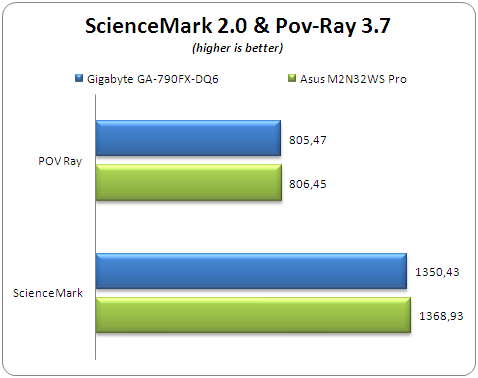
Both Pov-Ray and ScienceMark test results are dominated from Asus...
- x264 Benchmark
x264 Benchmark
utilizes the next generation of Video Encoding benchmarks with support
for x264 codec that is considered to be one of the most demanding for
Video applications. Simply put, this test measures how fast your
machine can encode a short, DVD quality MPEG-2 video clip into a
high-quality x264 video clip. The author believes that "...it's
ideal for a benchmark because the application (x264.exe) reports fairly
accurate compression results (in frames per second) for each pass of
the video encoding process, and it uses multi-core processors very
efficiently..."

The benchmark procedure is very simple, you just run a batch file
that encodes the same file five times. There are two kinds of results,
for first pass and second. We sum and divide the results in order to
get an average performance and we post the results below.
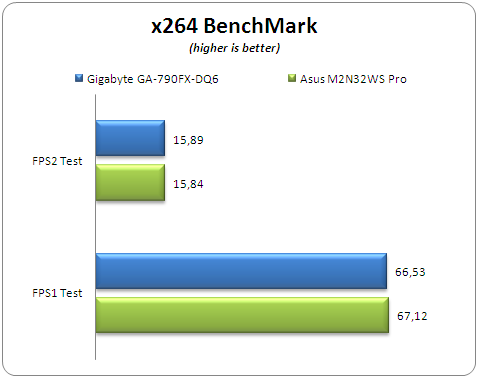
Again the lowest CL4 memory timings gave Asus M2N32WS Pro the precedence.
9. CineBench
 MAXON CINEBENCH
is based on MAXON's award-winning animation software, CINEMA 4D, which
is used extensively by studios and production houses worldwide for 3D
content creation. MAXON software has been used in blockbuster movies
such and Spider-Man, Star Wars, The Chronicles of Narnia and many more.
MAXON CINEBENCH runs several tests on your computer to measure the
performance of the main processor and the graphics card under real
world circumstances. The benchmark application makes use of up to 16
CPUs or CPU cores and is available for Windows (32-bit and 64-Bit) and
Macintosh (PPC and Intel-based). The resulting values among different
operating systems are 100% comparable and therefore very useful with
regard to purchasing decision-making.
MAXON CINEBENCH
is based on MAXON's award-winning animation software, CINEMA 4D, which
is used extensively by studios and production houses worldwide for 3D
content creation. MAXON software has been used in blockbuster movies
such and Spider-Man, Star Wars, The Chronicles of Narnia and many more.
MAXON CINEBENCH runs several tests on your computer to measure the
performance of the main processor and the graphics card under real
world circumstances. The benchmark application makes use of up to 16
CPUs or CPU cores and is available for Windows (32-bit and 64-Bit) and
Macintosh (PPC and Intel-based). The resulting values among different
operating systems are 100% comparable and therefore very useful with
regard to purchasing decision-making.
All tests were concluded with the R9.5 and R10 build and each
result is presented in a different graph for your consideration. Note
that all displayed index scores are the summary of CPU index scores.
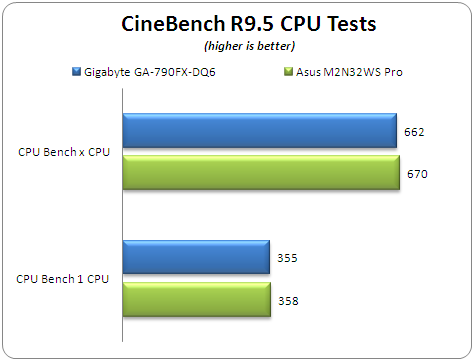
The result is the same in both tests, Asus M2N32WS Pro came first.
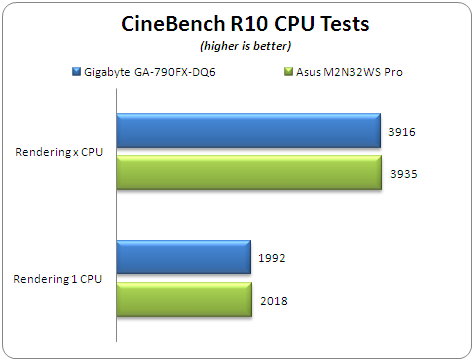
10. SuperPI
SuperPI
has become an utility to benchmark modern systems. In August 1995, the
calculation of pi up to 4,294,960,000 decimal digits was succeeded by
using a supercomputer at the University of Tokyo. The program was
written by D.Takahashi and he collaborated with Dr. Y.Kanada at the
computer center, the University of Tokyo. This record-breaking program
was ported to personal computer environment such as Windows NT and
Windows 95 and called Super PI.

The software offers up to 32M calculations of PI numbers, we summed
all test results and we compare the performance of the tested
motherboards

Apparently Gigabyte GA-790FX-DQ6 showed good performance and got the lowest SuperPI score.
11. SySmark 2007, WorldBench 6
 BAPCo's SYSmark 2007 Preview
builds upon its predecessors and is the next generation of benchmark
utilities that unitiliaze real life applications like: Adobe After
Effects 7, Adobe Illustrator CS2, Adobe Photoshop CS2, AutoDesk 3ds Max
8, Macromedia Flash 8, Microsoft Excel 2003, Microsoft Outlook 2003,
Microsoft PowerPoint 2003, Microsoft Word 2003, Microsoft Project 2003,
Microsoft Windows Media™ Encoder 9 series, Sony Vegas 7, SketchUp 5 and
WinZip 10.0.
BAPCo's SYSmark 2007 Preview
builds upon its predecessors and is the next generation of benchmark
utilities that unitiliaze real life applications like: Adobe After
Effects 7, Adobe Illustrator CS2, Adobe Photoshop CS2, AutoDesk 3ds Max
8, Macromedia Flash 8, Microsoft Excel 2003, Microsoft Outlook 2003,
Microsoft PowerPoint 2003, Microsoft Word 2003, Microsoft Project 2003,
Microsoft Windows Media™ Encoder 9 series, Sony Vegas 7, SketchUp 5 and
WinZip 10.0.
SYSmark 2007 Preview is an application-based benchmark that reflects
usage patterns of business users in the areas of Video creation,
E-learning, 3D Modeling and Office Productivity. This new release
includes a robust and refreshed set of applications. All results are
directly comparable between various configurations and operating
systems.
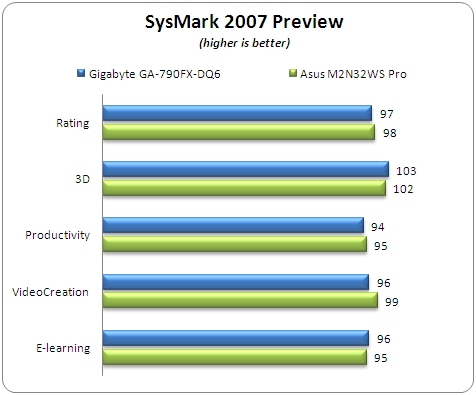
Minor differences between both tested motherboards...
 PC World has developed a new benchmark for testing PC system performance, WorldBench
has reached six (6) number and now is compatible with Windows Vista.
Much like as SysMark, it uses various real life applications (Adobe
Photoshop CS2, Autodesk 3ds max 8.0 SP-3, Firefox 2, Microsoft Office
2003 with SP-1, Microsoft Windows Media Encoder 9.0, Nero 7 Ultra
Edition, Roxio VideoWave Movie Creator 1.5 and WinZip Computing WinZip
10.0) and with pre-defined usage patterns calculates a total score that
can be used to evaluate a system's performance.
PC World has developed a new benchmark for testing PC system performance, WorldBench
has reached six (6) number and now is compatible with Windows Vista.
Much like as SysMark, it uses various real life applications (Adobe
Photoshop CS2, Autodesk 3ds max 8.0 SP-3, Firefox 2, Microsoft Office
2003 with SP-1, Microsoft Windows Media Encoder 9.0, Nero 7 Ultra
Edition, Roxio VideoWave Movie Creator 1.5 and WinZip Computing WinZip
10.0) and with pre-defined usage patterns calculates a total score that
can be used to evaluate a system's performance.
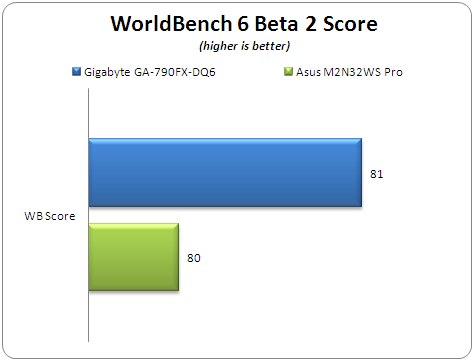
The highest score in this roundup was from Gigabyte GA-790FX-DQ6.
12. Lost Planet: Extreme Condition
The game's plot focuses on the amnesiac character Wayne Holden, his
father, Gale Holden, and the past and future of the planet E.D.N. III.
After a particularly vicious battle against a large Akrid known only as
"Green Eye", Gale is supposedly killed, and Wayne lost on the icy
planes of E.D.N. III . The planet of E.D.N III is perpetually cold and
snowy, originally inhabited by a species of aliens known as Akrid, who
forced humanity to abandon E.D.N. III by strength of numbers and
surprise, which can be found in many and varied forms.

They all share one trait; Thermal Energy, or T.Eng., as it's called
in the game. This powerful energy source, found only in Akrid bodies,
made humankind determined to fight them after having to retreat from
this new menace. They created the Vital Suit, or VS, technology,
essentially heated mechs with mounted weapons and powered by T.Eng.

In order to benchmark graphic cards, we used the Demo version that
includes a "Performance Test" function. We used the default demo visual
settings for all test. There are two test results from two different
animated courses that being reported as "Snow" and "Cave":

Let's now see the performance of the tested motherboards:

Exactly the same performance from both motherboards...
13. Overclocking
In our first test, all tested motherboards must achieve the highest
CPU speed with all BIOS settings left to Auto. This means that each
motherboard must figure out how much voltage the CPU needs in order to
be absolutely stable. Memory dividers and memory/FSB/MCH voltages are
also left to Auto. In other words this is the easiest overclocking
method you can do.

Keeping the CPU multiplier at 12x, Gigabyte GA-790FX-DQ6 reached
2640MHz, while Asus M2N32WS Pro was somewhat faster reaching
2720MHz.
2nd Test
Except from the maximum CPU speed, we have to find the maximum
possible FSB frequency with our used CPU. Again all BIOS settings are
left to Auto and the CPU multiplier is dropped down to 5x, while the HT
dropped to 200MHz. Memory timings and dividers are also left to auto.

With Auto voltage settings we got a totally stable 310MHz FSB for Gigabyte GA-790FX-DQ6.
- Overclocking stability
We have a mixed image for Gigabyte's overclocking stability. Several
times it did managed to post after a failure, however several times
didn't and required to perform the Clear CMOS function in order to
restore it. We assume that this behavior will improve in future BIOS
updates.
14. Conclusion
 AMD
and ATI worked together to produce the RD790 for the AM2/AM2+
socket upcoming processors. There are two major and important features
that makes the RD790 stand out, the PCI-e v2.0 support and the four
PCI-e slots for a Quad Crossfire setup. Those two features appeal
interesting in gamers wishing to use them and of course pay the
corresponding price.
AMD
and ATI worked together to produce the RD790 for the AM2/AM2+
socket upcoming processors. There are two major and important features
that makes the RD790 stand out, the PCI-e v2.0 support and the four
PCI-e slots for a Quad Crossfire setup. Those two features appeal
interesting in gamers wishing to use them and of course pay the
corresponding price.
The Gigabyte GA-MA790FX-DQ6 is the first motherboard in the market
that comes with the RD790. Due to Phenom indisposition, we tested the
motherboard with an Athlon X2 4600+ processor. We used the same
components and we had a direct comparison with a Nvidia 590SLI
motherboard from Asus (M2N32 WS Pro). Before the tests we had the
strange feeling of who will be the winner between those two boards,
since with the Gigabyte we couldn't achieve CL4 for the tested memory
at 400MHz. The thing is that the performance gap between the two
tested boards isn't that big, but if the Gigabyte could
achieve CL4, things might be different.

Passing to the board itself, the layout is clean and most major
parts can be easily identified. The biggest issue might be the fact
that the four PCI-e slots are very close to each other, so if you are
dreaming of a Quad Crossfire setup, you will need to get the
appropriate graphic cards. Gigabyte could make a better board design
concerning this issue. Of course four (4) memory banks are present,
four SATA2 connectors and many ports at the back panel.

Concluding this review, we feel that this motherboard aims at a
specific target group, since there are not so many "hot" new
improvements that could justify the increased price, compared to
Nvidia's 590SLI. Things might change when the AMD Phenom hits the
market, then we will see the true performance of the RD790 with the
1066MHz memory bandwidth and if we are lucky enough to get four
identical ATI based graphics cards, a Quad Crossfire setup. For the
retail price of 230 Euro, users must decide if those
new features are really that interesting to make an upgrade of a
current system setup. Upcoming buyers of Phenom, should consider this
motherboard since it includes all the needed features to unleash the
true power of AMD's future processors
| Retail package |
|
| Features |
|
| Price |
|
| Bios |
|
| Performance |
|
| Overclocking performance |
|
| Overclocking stability |
|